- Home
- Where Palms Grow
- Palms For AZ Deserts
Arizona Desert Palm Trees
Overview to Choosing the Best
Arizona desert palm trees can make your desert home a tropical palm retreat!
Yes, you heard it right. Palm trees aren't just for beaches; they can succeed in the Arizona desert's warmer, dry climate. Mother Nature got creative here, allowing these desert palm trees to flourish amidst cacti.
Because we live in Arizona's Sonoran Desert:
- We can give you info on which palm trees are most suitable for Arizona's desert clime.
- We can give you tips on growing them successfully in this arid region.
- We can give details to help Arizonans & visitors identify what palms they see.
There are also two other deserts in AZ:
- The Chihuahuan Desert in the southeast corner.
- The Mojave Desert in the northwest corner.
- BUT - some say the Great Basin Desert takes up the northeast. We don't agree!
 Map of the Great Basin Desert doesn't overlap into Arizona
Map of the Great Basin Desert doesn't overlap into ArizonaPer the USGS (U.S. Geological Survey)
Feeling overwhelmed by so many palm trees?
You're not alone. We Understand your headaches! At Mission: Palm Trees you'll find clear answers to questions & Step-By-Step Guidance, from real people. With solutions to help. No puzzling shoptalk. No tiring research. So it's easy & fun for you.
Top Desert-Adapted Palms for Arizona Landscapes
Where Do Palm Trees Grow in the Arizona desert? And what palms are they?
Species in about 28 palm tree Genera can be suitable for arid regions.
- Are you a desert dweller desiring some tropic-like charm in your yard?
- Are you a visitor to the desert curious about the local flora?
- Are you just interested in the varieties of palm environments?
As drought-tolerant palms, those in Arizona deserts don't need frequent watering. We'll show you the "Need to Knows" about the Best Arizona Palm Trees that are most practical to grow.
Because Arizona desert palm trees enhance our desert landscapes.
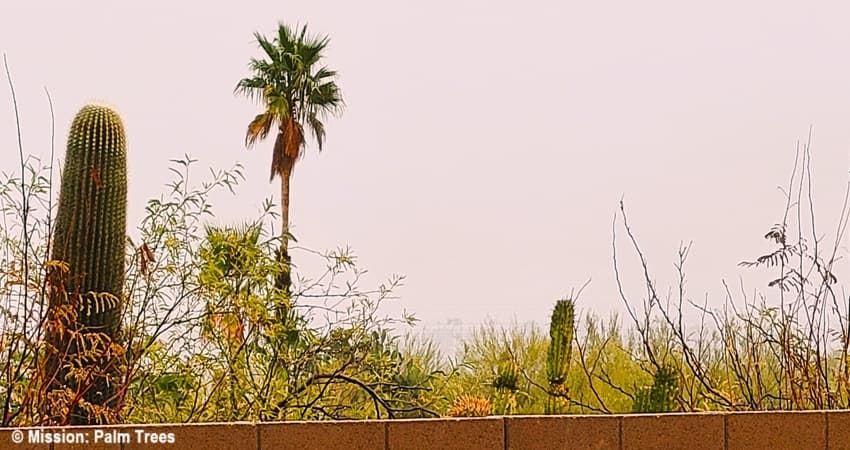 Palm in the Arizona desert overlooking saguaro cacti.
Palm in the Arizona desert overlooking saguaro cacti.Mexican Fan Palm (Washingtonia robusta):
Size, Growth & Hardiness
Scientifically known as Washingtonia robusta.
Think of those very Tall Palms in Los Angeles - something southern California is known for. But it's also an Arizona desert palm tree.
How Big do Mexican fan palms get?
The Mexican Fan will pretty quickly reach an impressive 70ft/21.3m. Along with Its tall, slender trunk it could even grow to 100ft/30.5m!
Its mostly round crown has around 30 bright deep green leaves way up. That helps it look full with those nice fan Types of Fronds.
 Line-up of tall Mexican Fan Palms as the sun lowers to the horizon.
Line-up of tall Mexican Fan Palms as the sun lowers to the horizon.Is a Mexican Fan Palm a Good Tree for the Backyard?
To evaluate the Washingtonia robusta for your property, ask yourself these questions:
- How large is my backyard? Is it roomy enough?
- How large is my house? Is it a two-story home?
These fan palms grow so tall. Possibly incompatible with your own Landscape Ideas. And lighting from storms will be attracted to its height.
Yet of course, your personal preference takes precedence when deciding on Arizona desert palm trees.
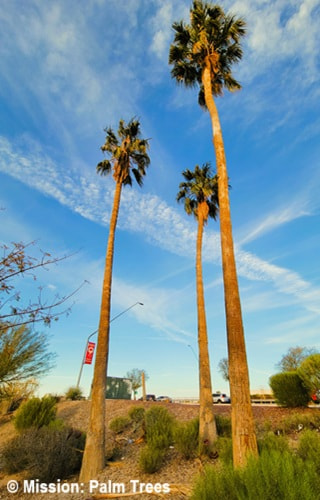 Robustas near a Tucson roadway
Robustas near a Tucson roadway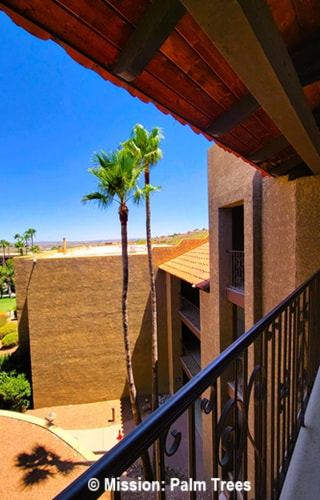 W. robustas at a resort outside Tucson
W. robustas at a resort outside TucsonMexican Fan Palm Care
It's relatively low-maintenance. Excellent for a busy lifestyle.
When young, robustas need a Regular Watering Plan. Once established, taper water back. It is drought tolerant. In fact, too much moisture and/or humidity can cause problems.
It needs a full day of sunlight. It's not concerned with soil type, but can use Periodic Fertilizing to look best.
It keeps its dead fronds for awhile, especially when young. But eventually they'll ditch them. If you don't like that look, you can get in a landscaper to trim them.
But please, ensure they Prune It Correctly.
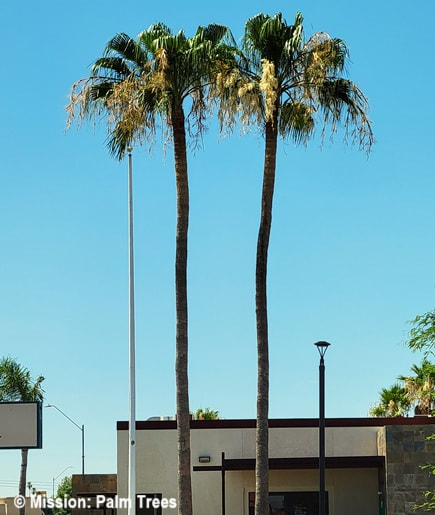 Somewhat Over-trimmed Mexican Palms in Yuma AZ
Somewhat Over-trimmed Mexican Palms in Yuma AZMexican Fan Problems
Overall, the Mexican Fan Palm is hardy. But some Palm Problems are Possible.
- Beware of the leaf stems (petioles), they're armed with spines.
- In humid areas, palmetto weevils could attack. Especially in southeastern US States, like Florida, SE Texas & Georgia.
- Scale Insects may be a problem for robusta palms. Prevention and Attention can handle it.
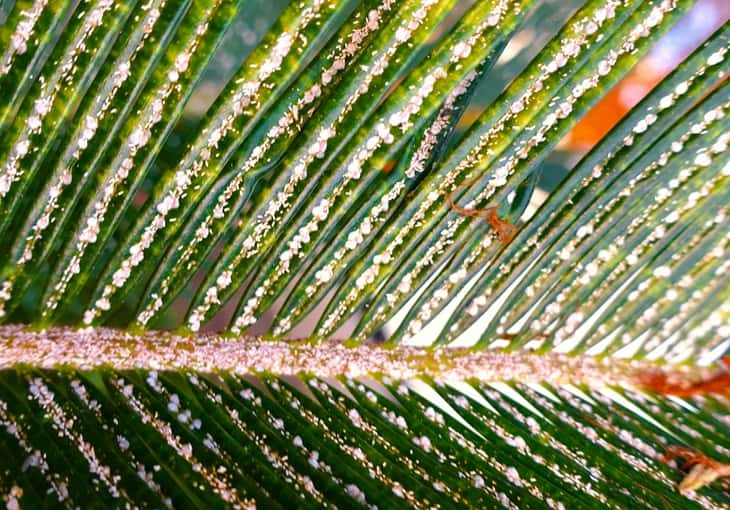 Evidence of Severe Scale Insect Infestation
Evidence of Severe Scale Insect InfestationCan a Mexican Fan Palm survive a freeze?
They grow in all Arizona desert cities, within the USDA Climate zones 9-11.
They're common where we live in Tucson. But in winter, freezing temps occasionally arrive - usually overnight with a cold front.
When the temperature dives to the low 20sF/-6.7sC they may show Some Freeze Damage. Yet they've been known to survive the teens/F or -9sC.
But these temps should be short-lived, without precipitation.
Date Palm (Phoenix dactylifera):
Fruit-Bearing Beauty in the Desert
The Date Palm's scientific name: Phoenix dactylifera.
It not only provides yummy dates, but it's often a local wildlife habitat. This drought-tolerant palm does well in the harsh desert full sun. Best in dry climes of USDA zones 7-11.
An average Watering Schedule does it good, as it's naturally found near oases or intermittent streams with groundwater.
 A Date Palm Grove in Arizona
A Date Palm Grove in ArizonaHow Tall Does the Date Palm Get?
Its towering height gets to 70ft/21.3m, with a slow to medium growth rate. It adds side-trunks by clustering as it ages. Offsets grow, which Can Be Propagated.
 Line-up of fruiting date palms.
Line-up of fruiting date palms.Where are Date Palms Native To?
Botanists believe their original roots were in North Africa and/or the Middle East. But haven't pin-pointed their origins.
These days they're an Arizona Desert Palm Tree. And in other places like in Southern California & Nevada.
They're still grown throughout the Middle East, where growing the Medjool Date Palm is a lucrative business.
 Four Date Palms keeping company in the UAE.
Four Date Palms keeping company in the UAE.Can You Eat Fruits From Date Palms in Arizona?
The sweet date palm fruit is edible. There are several varietals like Medjool, Khadrawi & Zahidi.
If you learn how to Germinate Date Palm Seeds, you could have your own date harvest right in your backyard!
One commercial Arizona date palm farm is in Dateland. Stop by if you're traveling Interstate-8, and try their delicious date shake!

Queen Palm (Syagrus romanzoffiana):
Fast-Growing, Majestic Fronds
The Syagrus romanzofiana palm looks like a beautiful tropical palm tree.
We see it all around us in Tucson AZ. It's excellent for Zones 9b-11, even has done fine in 8b-9a.
- Were you wondering about Queen Palms surviving in the hot clime of Phoenix? They're in Zone 9a, so it's good with proper care.
- Despite that it has some cold-weather tolerance.
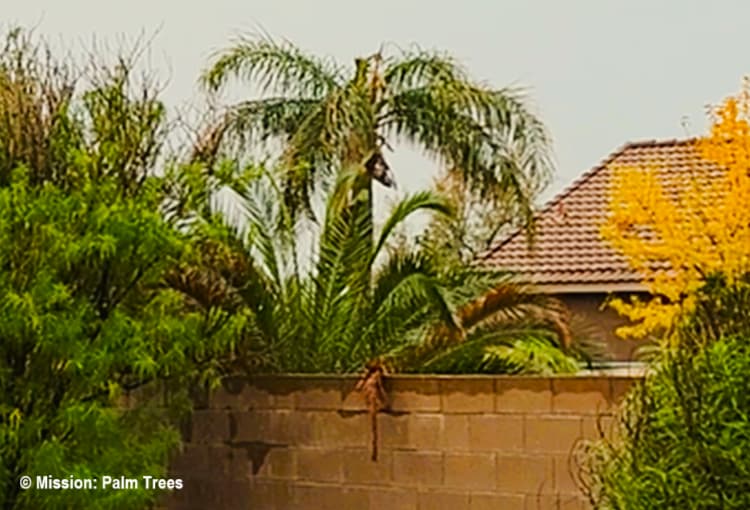 This Queen has been suffering over the past few years. In our neighbor's yard.
This Queen has been suffering over the past few years. In our neighbor's yard.How Big Does a Queen Palm Tree Get?
The Queen will grow quickly to 45ft/13.5m before you blink an eye!
Caring for it properly will speed it up more. If you're looking for a palm to establish itself quickly, here it is!
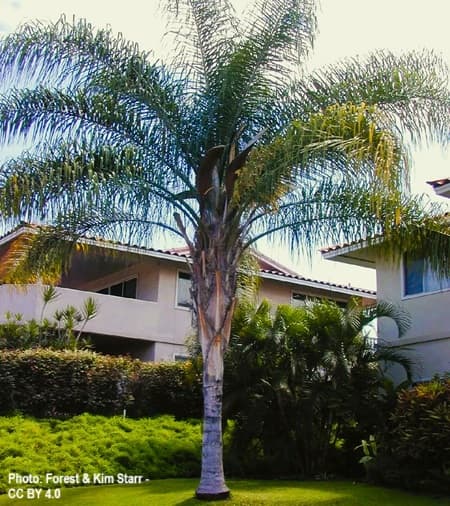
Queen Palm Tree Care
SUNLIGHT - Best with full sun, but minimal shady time will be okay.
NUTRITION - It needs plentiful regular water, and consistency in fertilization.
PRUNING - Not needed, as it will drop its dead leaves quickly.
SOIL - It doesn't do very well in calcareous (alkaline) soil. Test yours simply by using the area's soil & vinegar.
What are the Cons of a Queen Palm?
Why are Queen Palms bad?
Let's evaluate several reasons:
- Roots don't strongly lodge into soil. A big storm, like a hurricane, can more easily knock it down.
- Wondered if Queen Palms are poisonous to dogs? No. 😊 But if one bites into fruit, there's a slight chance of mouth & throat irritation.
- Queen palm drops large quantities of fruit, messy to some people. Its Seeds Grow Easily.
 Inflorescence packed with fruit.
Inflorescence packed with fruit.- Fusarium wilt is uncommon but has been documented.
- Maybe the commonest problem: Frizzle top occurs without a Good Palm Fertilizer Plan. Cause: insufficient manganese. Other micronutrients like Boron should be in the fertilizer.
Canary Island Date Palm (Phoenix canariensis):
Slow Grower, Long Lifespan
The Canary Island Date Palm does quite well as an Arizona desert palm tree. This species is seen in Tucson, looking fantastic with its full round crown of at least 100 fronds.
How big do Canary Island Date Palms get?
- You can't miss them, with their full grown 40-70ft/12-21m height.
- This palm's growth rate is fairly slow.
 A nice one in the Canary Islands
A nice one in the Canary IslandsCan You Eat the Dates from a Canary Island Date Palm?
 Dates grow from the mid-part of the fronds.
Dates grow from the mid-part of the fronds.The Canary Island Date Palm fruit is technically edible.
But would you want to eat it? The fleshy area of the fruit is quite thin, so not much to it. Most important, they're usually considered nasty to the taste buds!

How to Look After a Canary Island Date Palm
Canary Island Date Palm care isn't overwhelming, when you know its needs.
CLIMATE - Zones 9-11 is fine. Add in 8b for dry climes. It is drought tolerant. And needs full sun.
NUTRITION - It's not fussy for soil, as long as it drains well. Overwatering can attract fungus. Ensure fertilizer supplies macronutrients like Magnesium to avoid Nutritional Problems.
NATURAL LIFE - If you're wondering what is the lifespan of a Canary Island date palm - quite long! When not affected by any Palm Problems, it's known to reach between 200-300 years old!
 This P. canariensis is only getting started in life!
This P. canariensis is only getting started in life!How to Trim Canary Palms?
Why would you want to chance Canary Palm tree trimming?
The palm eventually eliminates the fronds, leaving the bases. Bases eventually wear off, making a smooth, decoratively patterned tan trunk.
A serious concern can happen when Over-pruning Palms. Some trim fronds to design it like a huge pineapple. Which causes susceptibility to Canary Island Date palm trunk rot.
- When trimming, the fungus Thielaviopsis paradoxa can enter through cuts.
- Symptoms appear on the upper trunk.
- Damaging the trunk from outside to inside.
Canary Island Palm Problems
Overall, it's quite hardy. But there are possible issues.
Are Canary island date palm spikes poisonous?
They're spikily dangerous, especially when young. If you're poked, irritation could occur. But it's not poisonous.
Canary Palm Tree Diseases
Although mostly hardy, Canary Palm disease rarely can occur.
- Lethal Yellowing happens when leafhoppers spread bacteria. It is fatal.
- Named for bright yellow color on oldest fronds.
- Yet the P.canariensis (and a few other species) leaf tips turn brown, then the whole frond, also.
- Fusarium Wilt is also a concern. Mostly spread by pruning shears used on infected palms.
- Palmetto Weevils Can Attack if it notes a distressed palm.
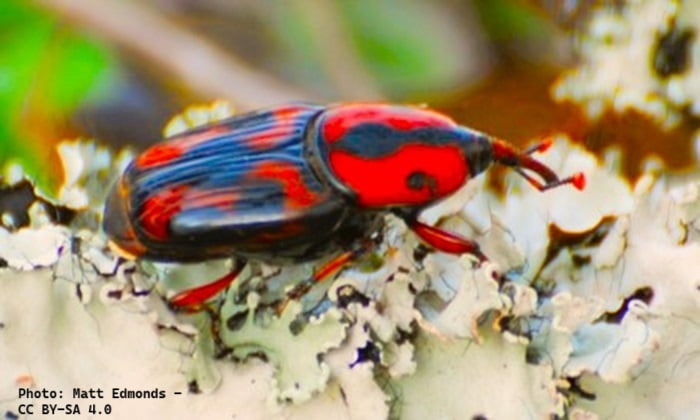 Palmetto Weevil grubs cause the harm.
Palmetto Weevil grubs cause the harm.Pygmy (Miniature) Date Palm (Phoenix roebelenii): Compact Charm
What is a Pygmy Date Palm?
P.roebelenii is adaptable for Desert Palm Tree Types. Fabulous for those looking for Arizona desert palm trees that aren't huge, but are still attractive. For hardiness zones: 9b-11, and arid climates of 8b-9a.
How big will Pygmy Date Palm get? Pygmy Palms, full grown, get about 10-15ft/3-4.5m tall. But somewhat slow growth rate.
Ripe fruits of the Pygmy Palm are black, and inedible.
Some of the best places to plant Miniature Date Palms is your front yard, along walkways or pool-sides. Great Palm for Smaller Spaces. Or try Container Planting on patios, or as an Indoor Palm with proper light & care.
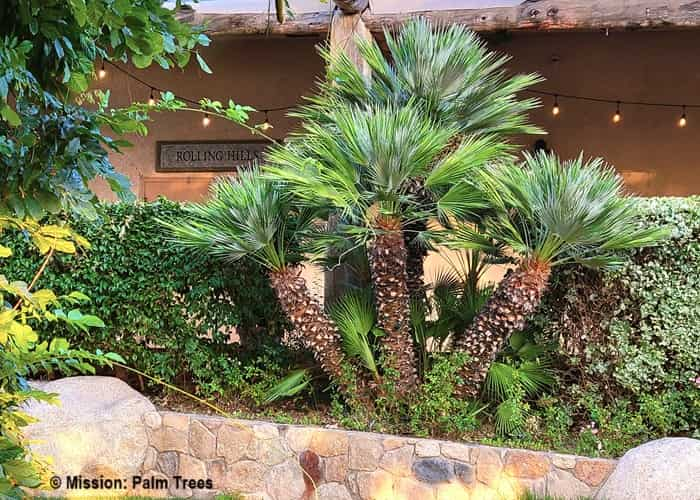 A trio growing together in front of a solitary - a bit over-trimmed.
A trio growing together in front of a solitary - a bit over-trimmed.On the grounds of a Southern California winery.
Pygmy Date Palm Care Outdoor
If you Purchase This Palm, consider the care, and evaluate your Landscaping Ideas.
SUNLIGHT - Do Pygmy Date Palms like sun or shade? They'll handle full sun or partial shade, but sunny spots speed its growth.
WATERING - One that needs extra watering compared to many desert palms. But it can do droughts, too.
SOIL - Essentially adaptable, but fine with added organic material.
NUTRITION - Important to fertilize with those containing Macronutrients and Micronutrients.
COLD TOLERATION - Pygmy date palm winter care shows that when established it resists winter temps down to freezing level.
Pygmy Date Palm Problems
Miniature Date Palms aren't faced with many problems.
- Watch for the spines on the stem.
- Potassium deficient Pygmy Palm's lowest fronds turn yellow-orange with black tips. Leading to leaf death.
- Other nutrient problems are possible.
Mediterranean Fan Palm (Chamaerops humilis):
Hardy Hedge Palm
European Fan Palm is another common name for Chamaerops humilis.
This multi-trunk (clustering) Mediterranean Fan Palm size can reach to 20ft/6m in height. Ideal for creating a lush, tropical bush or hedge, as it spreads out 6-30ft/8-9m.
The growth rate is kind-of slow, good growing conditions can speed it up.
 Can you picture it as a border hedge for your yard?
Can you picture it as a border hedge for your yard?Mediterranean Palm Care
HARDINESS ZONES - Ideal for USDA Zones 8b-11, 8a in arid climates. Cold hardiness takes it to 16oF/-8.9oC usually without harm.
WATER - Water needs are low when established. Watering slightly more often improves appearance. It hates humidity & soggy soil, which promotes Pink Rot.
SUNLIGHT - It really prefers sun all day long.
Mediterranean Fan Palm Problems
Mediterranean Fan Palm diseases aren't too common with proper care. But some insects attack.
- For southern Europe, beware of planthoppers that feed on sap.
- The Palm Borer Moth attack this Genera, as does the Banana Moth larvae.
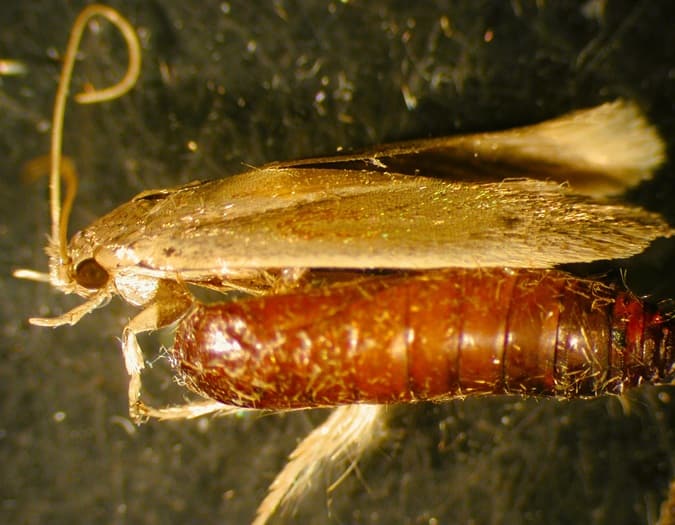 The Opogona sacchari adult (Banana Moth) specimen & its larva container.
The Opogona sacchari adult (Banana Moth) specimen & its larva container.Windmill Palm (Trachycarpus fortunei):
Cold-Tolerant Desert Option
Trachycarpus fortunei is a trooper, with its excellent cold tolerance.
It endures occasional Arizona frostiness without flinching. Your go-to palm if you're in cooler zones like 7/8. But also doable for Climate Zones 9-11. Cool Mediterranean climates suite it best. So, consider if it's really worth the trouble as an Arizona desert palm tree.
What does a windmill palm look like?
- It's a palmate (fan) palm, averaging 25 fronds in the round crown.
- When it flowers with yellow blooms, you'll detect a rare lovely fragrance.
- The trunk looks heftier than it is, because of retained fibrous leaf bases.
It looks like this:
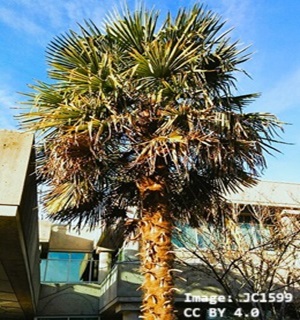 Windmill Palms are Quite Tolerant & Usually Do Well.
Windmill Palms are Quite Tolerant & Usually Do Well.How Tall Does a Windmill Palm Get?
Windmill Palm height gets between 25ft/7.5m to 50ft/15m, with its solitary trunk.
That height range depends on growing conditions, and the hardiness zone. The Windmill Palm (aka Chusan Palm) growth rate is slow to average. Speeding up when it loves where it lives!
What is the Best Place to Plant a Windmill Palm?
SOIL - No fussiness at all.
SUN - Give it a good day's percentage of sun. But in warmer climates like Arizona, give it some shade.
- Like our Tucson backyard (the only place we could plant one, per our HOA 🙄) is sunny!
WATER - Average regular watering schedule is fine. There's some drought tolerance.
Windmill Palm Fruit
The fruit has a rough hard surface.
- Purplish-blue color & half inch long oval shape.
- Were you wondering if the fruit of the Windmill Palm is edible? No, you wouldn't like it!
Windmill Palm Problems
One relief is that Windmill Palm stems (petioles) have spines, but they're not sharp.
- Protect it from wind in your placement. Storms won't do it justice, tearing up the leaves.
- The Prime Palm Problem is its slight susceptibility to Lethal Yellowing.
- Wilting fronds occur if attacked by Fusarium proliferatum fungus.
- The Palm Moth larvae is problematic in some European countries.
Newest MPT Page
-
Backyard Palm Tree Ideas Make Your Space Feel Like a Tropical Escape
Bring a resort feel home. Explore inspiring backyard palm tree ideas with themes like clustering, layering, and lighting designs for any space.
Sago Palms for Arizona
The Sago Palm is a unique choice.
It's not a palm, not even a relative, despite the name. The Sago Palm's scientific name is Cycas revoluta. Similarities to true palms are:
- It has a palmy appearance, with feathery leaves.
- New leaves grow from the top.
As gymnosperms, Sago Palm blooms are cones or globes, not flowers. They produce inedible seeds. The Sago Palm growth rate is exceedingly slow.
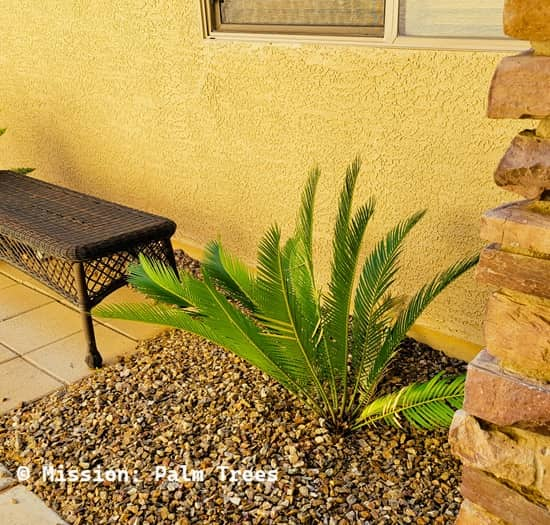 See how the Sago Palm has the pinnate palm look.
See how the Sago Palm has the pinnate palm look.This one grows slowly near our daughter's front door.
Sago Palm Care Instructions
This prehistoric, fern-like plant does well in desert climates with proper care.
SAGO PALM HARDINESS: Its cold hardiness makes it doable for Zones 8+. So a Sago Palm in Arizona deserts is feasible with caution. Winter temps down to the Fahrenheit teens & Celsius -7 requires protection. Frost damages it.
LIGHT: Do sago palms need sun or shade? The harsh desert sun can harm leaves. Shelter it with placement in indirect sunlight.
WATER: Keep the soil moist, definitely not soggy. When established they're drought capable.
SOIL: Sago Palm soil type should drain well & have a neutral pH.
INDOORS: As a Sago palm houseplant, maintenance is easy. Note the light, water & soil needs above.
Sago Palm Problems & Disadvantages
POISONOUS: Major Problem, as any part can be Lethal to Your Pet Animals Especially Dogs - if eaten. Especially the seeds. From the toxin cycasin. If you must handle it, protect your hands & arms, as toxins can be absorbed by skin. Therefore It also Harms People.
INSECTS or DISEASES: Possibility of Scale & Mealybug Insect attack.
NUTRITION: Most common is manganese deficiency. Symptoms will be Sago Palm yellowing. Prevent by using Palm Fertilizer with micronutrients.
California Fan Palm (Washingtonia filifera):
Arizona’s Only Native Palm
Even though many Palm Species grow here in Arizona, there's only one native.
The Washingtonia filifera is Arizona's endemic palm. Also called the Desert Fan Palm. Here in Arizona, it first grew in Arizona's Palm Canyon in the western part of the state.
It has a stocky, thick trunk vs the Mexican Fan Palm which is taller and slimmer.
Our Top Pick - Bismarck Palm
A Striking Desert Specimen
Bismarckia nobilis is a gorgeous, sturdy-looking palm. It can reach 60ft/18m tall, somewhat quickly.
Best suited for USDA zones 9b-11. With caution in 9a.
We're hoping to plant one in our backyard soon. Because of its gorgeous, sturdy look. And the stunning coloration of its 10ft/3m wide, stiff costapalmate fronds.
WATER: Medium when young, then mostly drought-tolerant.
SUN: Loves sunlight all day. Making them suitable as Arizona desert palm trees.
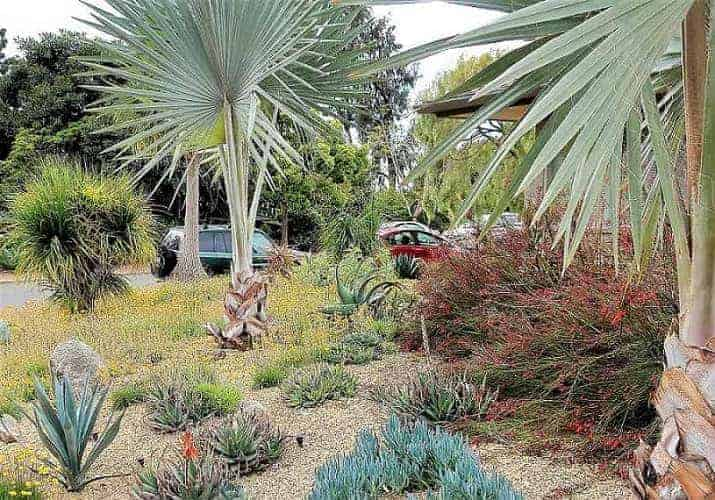 Two Bismarck Palms in a desert park.
Two Bismarck Palms in a desert park.Pindo (Jelly) Palm (Butia capitata):
Edible Fruit & Drought Tolerance
B.capitata nicknamed Jelly Palm because its fruit can be used to make jam, jelly, etc.
A more compact palm, reaching 35ft/10.5m tall. It doesn't fully shed its pinnate fronds, hanging onto a bit of the petioles.
It's very hardy, good for Zones 8-11 in dry areas, but not 8 in damp, humid zones.
WATER: Usually needs regular watering but can tolerate less.
SUN: Likes sunny spots, but a little shade won't hurt.
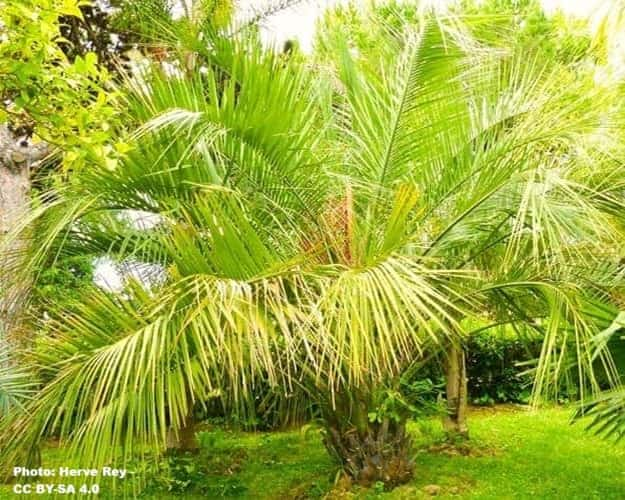 Pindo palm growing well in a grassy landscape.
Pindo palm growing well in a grassy landscape.Arizona Landscaping Guide
How do you decide which palm to plant?
Start with Your Landscape Plan.
- Consider the space you have
- Consider the environment of your own microclimate in Your Climate Zone.
- Consider the look you want: tall and majestic or compact and cozy.
Advance Planning will help you decide.
Best Time to Plant Palm Trees in Arizona
As you've seen, Arizona desert palm trees are a thing.
Plant your Arizona desert palm sometime between May & July. The University of Arizona Cooperative Extension reports that soil temperatures need to be at least 65°F/18.3°C. This promotes new root growth, so your palm will start becoming established.
Remember planting your palm is just the beginning.
How Do You Care for Palm Trees in Arizona?
If you plant the Best Arizona Desert Palm Trees, it requires checking for soil drainage in advance to help good growth. Most desert palms object to soggy roots.
Once they’re established, they’ll normally tolerate the desert’s extreme conditions.
FAQs: Lifespan, Height & Best Planting Time
Which Palm Grows Tallest in Arizona?
Which Palm Grows Tallest in Arizona?
Without a doubt, the palm that grows the tallest in Arizona is the Mexican Fan Palm. See all the details about the Washingtonia robusta BY CLICKING HERE>
What is the difference between a Mexican fan palm and a fan palm?
What is the difference between a Mexican fan palm and a fan palm?
A fan palm is a way to categorize palm trees by the look of their fronds. Knowing the vocabulary for Parts of Palm Fronds is good when discussing palms.
A Mexican Fan Palm (Washingtonia robusta) is just one of many types of palms in Arizona that have fan-like leaves. Called pinnate fronds.
What is the best time to plant palm trees in Arizona?
What is the best time to plant palm trees in Arizona?
The outside spot you've chosen must have warm enough soil. Therefore, the best planting time is late spring to early summer. See More Detail Here>
How Much Water Does Each Palm Type Require?
How Much Water Does Each Palm Type Require?
Water deeply, since most of these suggestions for Arizona desert palm trees rely on the needs in Their Native Environment. Which is typically near a water source, like an oasis.
Water beyond the immediate trunk area, go at least 4ft/1.22m outward. Then you'll need to satisfy their thirst by watering 2ft/61cm deep, at a minimum.
Watering frequency is based on the Type of Soil, local weather, and the species' water needs. Evaluate when the top 3in/7.62cm of soil dries out. Then it's time for a watering.
Can You Eat Fruits from Arizona-Grown Date Palms?
Can You Eat Fruits from Arizona-Grown Date Palms?
Arizona grows Edible Date Palms just for that purpose. So you can eat the tasty date fruits. See more About Date Palms in Arizona.
What is the difference between a Queen Palm and a Royal Palm?
What is the difference between a Queen Palm and a Royal Palm?
These two palms differ for their Genera. What else?
- A Queen Palm does fine in USDA 9b-11, but the Royal (Roystonea regia) might do 9b in warm desert microclimates.
- The Royal gets much taller, 80-100ft/24-30m. Both grow quickly.
- The Royal has a Crown Shaft, while a Queen doesn't. Yet a Queen does drop old, dead fronds.
Though they both have that aristocratic common name, that doesn't really connect them!
Takeaways for Arizona Desert Palm Trees
Transform your desert garden into that oasis you've always dreamed of.
With so many options for Arizona desert palm trees, choose the perfect palm waiting just for you. Who knew the desert could be this palm-friendly?





